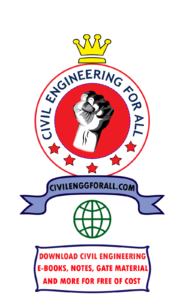
CONTENTS
- Hydraulics
- Kinematics of Flow
- Continuity Equations
- Fluid Displacements
- Circulation
- Stream Function
- Correction Factors
- Turbulent Flow
- Boundary Layer Theory
- Open Channel Flow
- Pumps And Turbines
- Specific Speed
- Turbines
- Cavitation
- Dimensional Analysis
- Ship Model Testing

Fluid Pressure
It is the pressure transmitted with equal intensity in all directions and acts normal to any plane. It is defined by limiting equation,

Pressure at a Point (Pascal’s Law)
Pressure intensity at a point is defined as the ratio of force acting on an elemental area and the elemental area as the area tends to zero at the point. This pressure is always normal to the surface, as fluid at rest cannot sustain any shear stress. If an elemental area is allowed to rotate freely in a fluid at rest, the pressure on the area will be of constant magnitude and is independent of the orientation of the area at the point. Then the pressure being scalar quantity must be same in all directions at a point. This is known as Pascal’s Law. Pressure at a point can be considered at the average of any three mutually perpendicular normal compressive stresses at a point, i.e. 1/3 (px + py + pz)

HYDRAULIC MACHINERY IES MASTER GATE STUDY MATERIAL PDF: CLICK HERE
Newtonian Fluids
Newtonian fluids tend to have a certain constant viscosity. For instance, many common fluids air, water, light oils gasoline or shear stress is linearly dependent upon velocity gradient.

The rate change of angular deformation is proportional to the shear stress, i.e.

A Newtonain fluid is a special case of power law fluid having n = 1 and B = 0 and the constant A varying only with the type of fluid.
Ideal Fluid
It has been utilised in the analytical treatment of flow phenomenon. An imaginary flow of fluid non viscous and incompressible (inelastic) is known as ideal fluid. In ideal fluid shear stress is linearly dependent on velocity gradient.
Buoyancy and Floatation
Archimedes Principle
When a body is totally or partially immersed in a fluid, it is lifted up by a force which is equal to the weight of the fluid displaced by the body. This vertical upward force is called the center of buoyancy (C.B) and it is at the center of gravity of the displaced fluid.
Stability of Submerged Bodies
For stability of submerged body, the center of gravity of the body must lie directly below the center of buoyancy (gravity) of the displaced fluid. The submerged body is in neutral equilibrium of all positions as long as the w.f. of the body and C.B. coincides.
FLUID MECHANICS ACE GATE STUDY MATERIAL PDF: CLICK HERE
Floatation
A body immersed in any fluid is acted upon by weight of body W acting vertically downward and buoyant force Fb acting vertically upwards. If W > FB, the body will sink. If W = FB, the body will remain in equilibrium at any level. If W < FB, the buoyant force will move the body upwards and the body will come to rest, when the buoyant force becomes equal to its weight. Then the body is said to be floating.
Principal of Floatation
The weight of a floating body is equal to the weight of the fluid displaced by the body.
Stability of Floating Bodies
For stability of floating cylinder or spheres the center of buoyancy (C.B.) should lie considerably below the w.f. (G) the body. Stability of other floating bodies will depend upon whether a righting or overturning moment is developed when the w.f. and C.B. move out of the vertical alignment due to the shifting of the position of C.B. The C.B. will shift because of the floating body tilts, the shape of displaced liquid changes and hence its w.f. shifts.
KINEMATICS OF FLOW
- A particular quantity of matter or specified region in space is designated as a ‘System’. All matter external to system is called its ‘Surroundings’. A closed system refers to a specified mass limited by the boundaries, e.g. a kg mass of air contained in a cylinder.
- An open system or control volume refers to definite fixed region in space through which the matter moves e.g., flow of air through a pipe.
- Process is a path of succession of state through which the systems passes e.g., change in pressure, velocity, elevation, density, temperature.
FLUID MECHANICS ACE ACADEMY GATE NOTES PDF: CLICK HERE
FLUID DISPLACEMENTS
Consider all possible motion of a cubical fluid element.
(a) Translations: When this element is bodily moved from one position to another position, such that the median lines do not change in length and they are parallel to their respective former positions, then the movement is called translation.
(b) Linear Deformation: When there is change in the length of median line without change in the orientation, such a type of motion is called linear deformation. Two dimensional fluid element of constant density will have both side lengths altered due to linear deformation.

(c) Angular Deformation: When the angle between two adjacent sides of a fluid element change such a type of motion is called angular deformation. The angular deformation results in an incompressible fluid, the volume of the fluid element remains constant, while the deformation takes place.

(d) Rotation: In the Fig. (d), the fluid element bodily rotates about the z-axis, i.e. perpendicular to the paper at point a. The average of the sum of the angular velocities of sides ab and ad is the net rotation of the fluid element about z-axis.
BOUNDARY LAYER THEORY
Prandtl gave a hypothesis, the fluid flowing along a solid wall may be divided into two independent regions:
- Fluid within a thin region adjacent to the boundary where the viscous effects are predominant and in know as boundary layer.
- Fluid outside this region, where ideal fluid flow exits. This region is known as main flow and velocity in this region approaches the free stream or potential velocity U.
Boundary Layer Flow over a Flat Plate

Consider a flat plate at zero incidence in an infinite extent of fluid. The fluid approaches the plate with uniform velocity U (or free stream velocity). As soon as it touches the plate at its leading edge, its velocity reduces to zero in accordance with the no slip condition. The velocity changes rapidly from zero at the boundary to its full value U within a short distance normal to the plate causing a large velocity gradient to developed in the boundary layer. Therefore even for a less viscous fluid (e.g. air or water) large shear resistance is developed over the plate and there by a sufficiently thick boundary layer is formed along the plate. As the flow proceeds downstream more fluid is retarded in the lateral direction thereby cursing boundary layer growth in the direction of flow.
Boundary Layer Thickness
Velocity of fluid u becomes zero at the stationary wall and becomes equal to free stream velocity U at certain distance normal to the plate. This variation becomes asymptotic in the vertical direction and hence this distance required will be too large to acquire free stream velocity U.
HYDRAULICS STUDY MATERIAL FOR SSC JE PDF CIVILENGGFORALL
DOWNLOAD LINK : CLICK HERE
PASSWORD : CivilEnggForAll
OTHER USEFUL BOOKS
- RAJASTHAN STAFF SELECTION BOARD (RSSB) JUNIOR ENGINEER DIPLOMA CIVIL ENGINEERING EXAM 2022 – HINDI & ENGLISH MEDIUM SOLVED PAPER – FREE DOWNLOAD PDF (CivilEnggForAll.com)
- ISRO TECHNICAL ASSISTANT EXAM 2022 – CIVIL ENGINEERING – HINDI & ENGLISH MEDIUM – SOLVED PAPER – FREE DOWNLOAD PDF (CivilEnggForAll.com)
- MADHYA PRADESH PUBLIC SERVICE (MPPSC) COMMISSION – ASSISTANT ENGINEER EXAM – MPPSC AE 2021 CIVIL ENGINEERING – SOLVED PAPER WITH EXPLANATIONS – PDF FREE DOWNLOAD
- BIHAR PUBLIC SERVICE COMMISSION (BPSC) ASSISTANT ENGINEER EXAM – 2022 – CIVIL ENGINEERING – SOLVED PAPER – FREE DOWNLOAD PDF (CivilEnggForAll.com)
- ODISHA PUBLIC SERVICE COMMISSION – OPSC AEE PANCHAYATI RAJ EXAM 2021 – SOLVED PAPER WITH EXPLANATION – FREE DOWNLOAD PDF





















